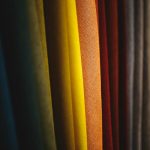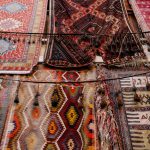You might not think of taffeta as a fabric that aligns with eco-friendly fashion, but its potential is worth exploring. With advancements in sustainable production methods and a growing emphasis on using recycled materials, taffeta is making a case for both elegance and environmental responsibility. As you consider the impact of your fashion choices, it raises an interesting question: how can a fabric known for its luxurious sheen also contribute to a more sustainable future? The answer might just change the way you view this classic material.
Table of Contents
Understanding Taffeta's Characteristics
Taffeta's crisp texture and lustrous finish make it a standout choice in eco-friendly fashion. When you touch taffeta, you can instantly feel its smooth, lightweight quality. This fabric holds its shape beautifully, giving garments a structured appearance that's perfect for more formal occasions.
Whether you're wearing a dress or a jacket, you'll appreciate how taffeta enhances your silhouette. Its ability to reflect light adds a unique flair, making it a popular choice for evening wear and special events. You'll find that taffeta drapes elegantly, conveying a sense of sophistication and style.
Plus, it's often made from natural fibers like silk or recycled materials, aligning with your desire for sustainable fashion options. Taffeta is also known for its durability. Unlike many other lightweight fabrics, it can withstand wear and tear, meaning you can enjoy your taffeta pieces for years to come.
This longevity contributes to a more sustainable wardrobe, as you'll reduce the need for frequent replacements. Overall, taffeta's combination of beauty, durability, and eco-friendliness makes it a fabric worth considering as you curate your sustainable fashion collection.
Embrace the elegance of taffeta, and enjoy its unique traits!
Sustainable Production Methods
When you choose taffeta made with sustainable production methods, you're supporting ethical sourcing practices that prioritize both people and the planet.
You'll also appreciate the beauty of low-impact dyeing techniques that reduce harmful chemical use while still delivering vibrant colors.
Together, these methods ensure that your fashion choices align with your values.
Ethical Sourcing Practices
Ethical sourcing practices consistently prioritize sustainable production methods to minimize environmental impact and promote social responsibility in the fashion industry. By choosing materials like taffeta that are sourced ethically, you support practices that respect both people and the planet. This means looking for suppliers who implement fair labor practices, ensure safe working conditions, and pay fair wages.
Here's a quick overview of key components in ethical sourcing:
| Component | Description | Benefits |
|---|---|---|
| Fair Labor Practices | Ensures workers receive fair wages | Boosts community well-being |
| Sustainable Materials | Uses eco-friendly fabrics like taffeta | Reduces environmental impact |
| Transparent Supply Chains | Maintains open communication with suppliers | Builds consumer trust |
| Local Sourcing | Supports local economies | Reduces carbon footprint |
When you shop for eco-friendly fashion, keep an eye out for brands that embrace these ethical sourcing practices. By doing so, you not only enhance your wardrobe but also contribute to a more sustainable and equitable fashion industry. Your choices matter, and they can drive positive change in the world of fashion.
Low-Impact Dyeing Techniques
Choosing taffeta made with low-impact dyeing techniques not only enhances your eco-friendly wardrobe but also significantly lessens the environmental footprint of fashion production. These innovative methods prioritize sustainability while maintaining vibrant colors and quality.
Here's what you should know:
- Natural Dyes: Often derived from plants, fruits, and minerals, these dyes are biodegradable and reduce harmful chemical usage.
- Low Water Usage: Techniques like digital printing require less water than traditional dyeing processes, conserving this precious resource.
- Non-Toxic Chemicals: Many low-impact techniques utilize eco-friendly alternatives to conventional dyes, minimizing toxic waste and pollution.
- Recyclable Materials: Some dyes can be made from recycled textiles, decreasing the demand for virgin materials and promoting a circular economy.
Taffeta From Recycled Materials
Taffeta made from recycled materials offers a sustainable alternative that reduces waste while maintaining the fabric's signature elegance. When you choose taffeta sourced from post-consumer or post-industrial waste, you're not just investing in a beautiful fabric; you're actively contributing to a more eco-friendly fashion industry.
Recycled taffeta is crafted from materials like discarded plastic bottles or leftover textiles. This process not only keeps these items out of landfills but also significantly lowers the energy required to produce new fabrics.
You'll find that many designers are embracing this innovative approach, creating stunning garments that showcase the versatility and style of recycled taffeta.
Whether you're dressing up for a special occasion or looking for unique pieces for everyday wear, choosing taffeta from recycled materials helps you make a statement about sustainability. It's a way to stand out while also supporting ethical fashion practices.
Organic Fibers in Taffeta
Organic fibers transform taffeta into a luxurious, sustainable option that's not only stylish but also gentle on the environment. By choosing organic fibers, you're opting for textiles that minimize your ecological footprint while enjoying the elegance of taffeta. These fibers are made from natural materials grown without harmful pesticides or synthetic fertilizers, allowing you to wear fashion that aligns with your values.
Here are four key benefits of organic fibers in taffeta:
- Eco-Friendly Production: Organic farming practices promote biodiversity and reduce pollution, making the production process more sustainable.
- Biodegradable: Unlike synthetic fibers, organic taffeta will decompose naturally, reducing landfill waste and environmental impact.
- Skin-Friendly: Organic fibers are typically free from harmful chemicals, making them gentler on your skin and ideal for those with sensitivities.
- Durability: High-quality organic fibers offer strength and resilience, ensuring your taffeta garments last longer, reducing the need for frequent replacements.
Taffeta's Role in Sustainable Fashion
When you think about sustainable fashion, consider taffeta's unique qualities.
Its biodegradable properties and the sustainable production practices behind it make it an excellent choice for eco-conscious consumers.
Biodegradable Properties of Taffeta
In recent years, the search for biodegradable materials in fashion has led to renewed interest in taffeta, which offers a more sustainable alternative to conventional fabrics. Unlike synthetic fibers, taffeta can break down naturally, making it a favorable choice for eco-conscious consumers. When you choose taffeta, you're embracing a material that aligns with sustainable practices.
Here are four key biodegradable properties of taffeta to consider:
- Natural Composition: Taffeta is often made from silk or other plant-based fibers, which decompose more readily than petroleum-based materials.
- Reduced Environmental Impact: When discarded, taffeta doesn't leave behind harmful microplastics, unlike many synthetic fabrics.
- Soil Enrichment: As it breaks down, taffeta can contribute nutrients back into the soil, promoting healthier ecosystems.
- Sustainable Lifecycle: You can incorporate taffeta into your wardrobe knowing it won't linger in landfills for decades.
Sustainable Production Practices
Taffeta stands out in sustainable fashion by embracing eco-friendly production practices that minimize environmental harm. By sourcing materials responsibly and employing innovative techniques, taffeta manufacturers contribute to a greener planet. You'll be pleased to know that many brands focus on reducing waste and energy consumption during production, ensuring a smaller ecological footprint.
Here's a quick overview of sustainable production practices in taffeta manufacturing:
| Production Practice | Benefits | Example |
|---|---|---|
| Organic Sourcing | Reduces chemical use | Organic silk taffeta |
| Water Conservation | Lowers water usage | Closed-loop water systems |
| Energy Efficiency | Minimizes carbon emissions | Solar-powered production facilities |
| Waste Reduction | Less landfill contribution | Recycled taffeta scraps |
| Ethical Labor Practices | Supports fair wages | Fair Trade certified manufacturers |
Future Trends in Taffeta Fashion
As designers embrace sustainability, you'll see taffeta evolving into innovative, eco-friendly fabrics that maintain its luxurious appeal. This shift isn't just about aesthetics; it's about making responsible choices that resonate with conscious consumers.
Here are some future trends you can expect in taffeta fashion:
- Recycled Materials: You'll find taffeta made from recycled plastics and textiles, reducing waste and promoting circular fashion.
- Natural Dyeing Techniques: Expect vibrant colors derived from plants and minerals, which not only look stunning but also minimize environmental impact.
- Biodegradable Options: Designers are exploring biodegradable taffeta alternatives, ensuring that your stylish choices won't linger in landfills for years.
- Smart Fabrics: Innovations in fabric technology will lead to taffeta that's not only beautiful but also functional—think moisture-wicking and temperature-regulating properties.
As these trends gain traction, you'll have the chance to embrace taffeta in a way that aligns with your values. This fusion of elegance and eco-consciousness means you can look fabulous while contributing to a more sustainable future.
Frequently Asked Questions
Is Taffeta Biodegradable or Compostable?
Taffeta isn't biodegradable or compostable. It's made from synthetic fibers, which don't break down easily. If you're looking for eco-friendly options, consider natural fibers instead, as they're more sustainable and environmentally friendly.
Can Taffeta Be Dyed Sustainably?
Yes, you can dye taffeta sustainably by using natural dyes or low-impact synthetic dyes. These methods reduce environmental harm, allowing you to achieve vibrant colors while minimizing the ecological footprint of your fashion choices.
How Does Taffeta Compare to Other Eco-Friendly Fabrics?
When you compare taffeta to other eco-friendly fabrics, you'll notice that while it's durable and elegant, it often lacks the biodegradability and sustainability of options like organic cotton or hemp, making it less eco-conscious overall.
What Are Common Uses for Taffeta in Fashion?
Taffeta's commonly used in evening gowns, bridal dresses, and formal wear due to its crisp texture and elegant drape. You'll also find it in linings, skirts, and accessories, adding a luxurious touch to various garments.
How Should I Care for Taffeta Garments Sustainably?
To care for taffeta garments sustainably, hand wash in cold water using mild detergent, avoid harsh chemicals, air dry, and store them away from direct sunlight. This keeps your taffeta looking great while minimizing environmental impact.
- How Does Ring Spun Cotton Affect Garment Fit and Shape Retention? - August 13, 2024
- What Are the Challenges in Producing Ring Spun Cotton? - August 13, 2024
- Is Ring Spun Cotton Suitable for Plus-Size Clothing? - August 13, 2024







